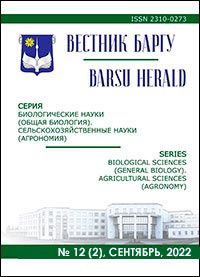ECOLOGICAL PLASTICITY OF JUNIPER (JUNIPERUS COMMUNIS L.)IN URBAN ENVIRONMENT
Keywords:
urban environment; common juniper; vital condition; life form; ecological plasticityAbstract
Urban environment is characterized by uniqueness of environmental factors, specificity of man-made effect, leading to significant transformation of the environment. Plants are the main factor in the ecological stabilization of
urban environment due to their vital activity, and, above all, photosynthesis and the ability to accumulate pollutants.
The aim of the work is to study bio-ecological features of the common juniper in urban environment. In the course of the research, it was found out, that in urbanized areas the spectrum of life forms in J. communis is more diverse
than in natural conditions. Along with single-stemmed trees that predominate in natural environment, small and multi-stemmed geoxyl trees and aeroxyl tree-bush are formed. In the conditions of the city of Minsk J. communis has
3 categories of life conditions: healthy, oppressed and severely oppressed plants. The main factors that determine the vital state of the common juniper are recreational load, and, to a lesser extent, the atmospheric air pollution.
Fig. 1. Table 4. Ref.: 8 titles.
Downloads
Published
Issue
Section
License
Copyright (c) 2023 Вестник БарГУ Серия "Биологические науки. Сельскохозяйственные науки"
Это произведение доступно по лицензии Creative Commons «Attribution-NonCommercial» («Атрибуция — Некоммерческое использование») 4.0 Всемирная.
Авторы сохраняют за собой право заключать определенные договорные соглашения, касающиеся неисключительного распространения опубликованной версии работы (например, размещать ее в институциональном репозитории, публикация в книге) со ссылкой на ее первоначальную публикацию в этом журнале.





